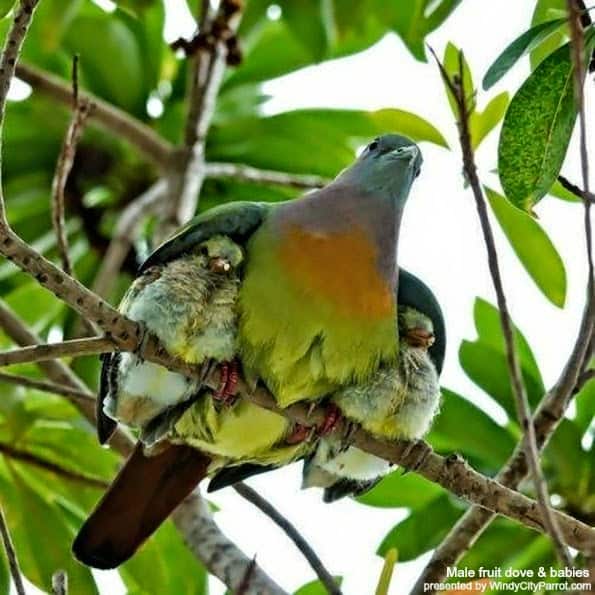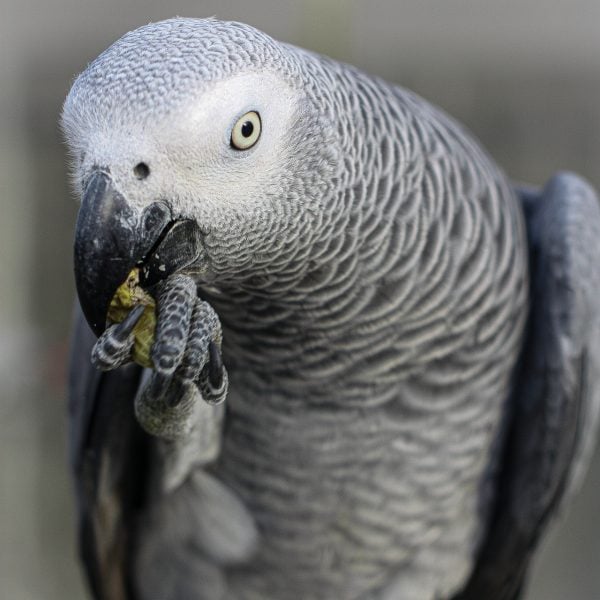Last Updated on by Mitch Rezman
Birds can have weird habits. I knew a Cherry-Headed Conure that loved to attack toes. Some birds will only eat food that has been through their water dish or will fall in love with a particular pair of shoes on your closet floor.
African Green Pigeons take weird habits to a new level. Pigeons in spite of not being mammals meaning I have no breasts are able to in fact produce milk. Pigeons generally incubate their eggs for about three weeks.
At about 10 days both the male and female feel the effects of the pituitary hormone prolactin (which as luck would have it is the same hormone that signals mammals to begin producing milk).

What actually happens is the crop gets thicker with an invasion of blood vessels. Three weeks into this process as chicks are being born, mom and dad pigeons have seen their crop triple in weight.
So much so that they have to get rid of some of this excess crop. They end up regurgitating something that can only be compared to something like cottage cheese (one of my favorite lunches smothered in Catalina dressing – Richard M Nixon, liked the very same lunch).
This white oozing milk-like secretion is called “crop milk” a.k.a. “pigeon milk”. Brand spanking new pigeons are called squabs and they can’t spend enough time pushing their heads in their mom and dad’s beaks to suck up the gooey goodness.
Ironically pigeon milk is similar to mammal milk having a lot of protein, fat & moisture but unlike breast milk it has no carbs. It’s actually healthier for the baby birds than the milk that we get at the grocery store. Nature’s design is such that this milk is only produced by mom and dad for about a week It’s nothing but solid bird food after that.
I appreciate motherhood and everything a woman must go through in order to produce and care for a child. But growing nutrients in your “throat” or “crop”? That’s a lot of work.
Baby pigeons don’t have to worry about a breeding pool of water drying out but flamingos do.
Baby flamingos need to grow fast. To help foster rapid growth baby flamingos, mom and dad unceremoniously bring up a mixture of blood and fat for cute little Freddie or Francine flamingo to feed on.
Why did Mother Nature introduce this level of feeding complexity to breeding pigeons? Can we talk?
Pigeons lay smaller eggs relative to the size of their bodies and little Peter and Penelope pigeon are pretty developed by the time they work their way out of the egg. Living here in Chicago with an endless supply of pigeons to “study”, many people have come to call them “flying rats” because of their extraordinary rapid development.
This is one more of nature’s trade-offs. She’s funny like that. These relatively mature chicks blow their just starting food budget (the yolk) by the time they have announced to the world that they have arrived.
This isn’t normal I tell you! The majority of bird chicks escape from the shell with as much as 33% of their yolk. In that it is stored in their tiny tummies, they can chill and enjoy a whole bunch of protein and fat without doing anything. Because of so much nutrition in most baby birds tummies, for the most part, they don’t have to be fed for the first few days so they can get ready to ingest solid food.
Pigeons hasten this whole process through the production of pigeon milk.
Whoda thunk it?
Written by Mitch Rezman
Approved by Catherine Tobsing
Author Profile
Latest entries
 The Traveling BirdJune 26, 2025Can You Name 5 Parrot Species That Are Living Wild in the USA?
The Traveling BirdJune 26, 2025Can You Name 5 Parrot Species That Are Living Wild in the USA? Bird BehaviorJune 26, 2025How is it Parrots Are Problem Solvers Social Animals and Even Use Tools?
Bird BehaviorJune 26, 2025How is it Parrots Are Problem Solvers Social Animals and Even Use Tools? Bird & Parrot AnatomyJune 25, 2025How a Tiny Chemical Modification Makes Parrots Nature’s Living Paintings
Bird & Parrot AnatomyJune 25, 2025How a Tiny Chemical Modification Makes Parrots Nature’s Living Paintings PigeonsJune 20, 2025How Do Parrots Thrive in Cities Outside Their Native Habitats?
PigeonsJune 20, 2025How Do Parrots Thrive in Cities Outside Their Native Habitats?




